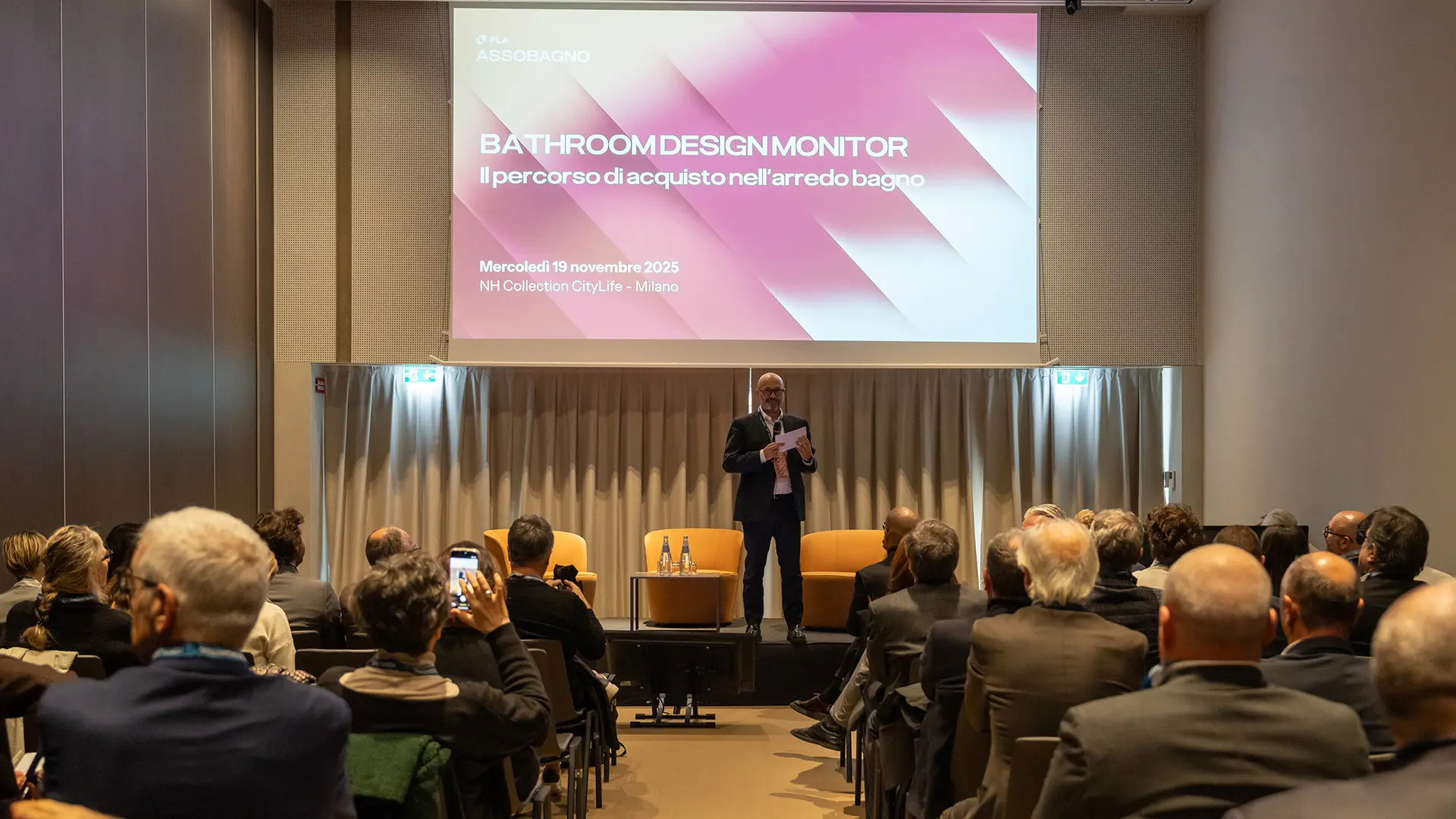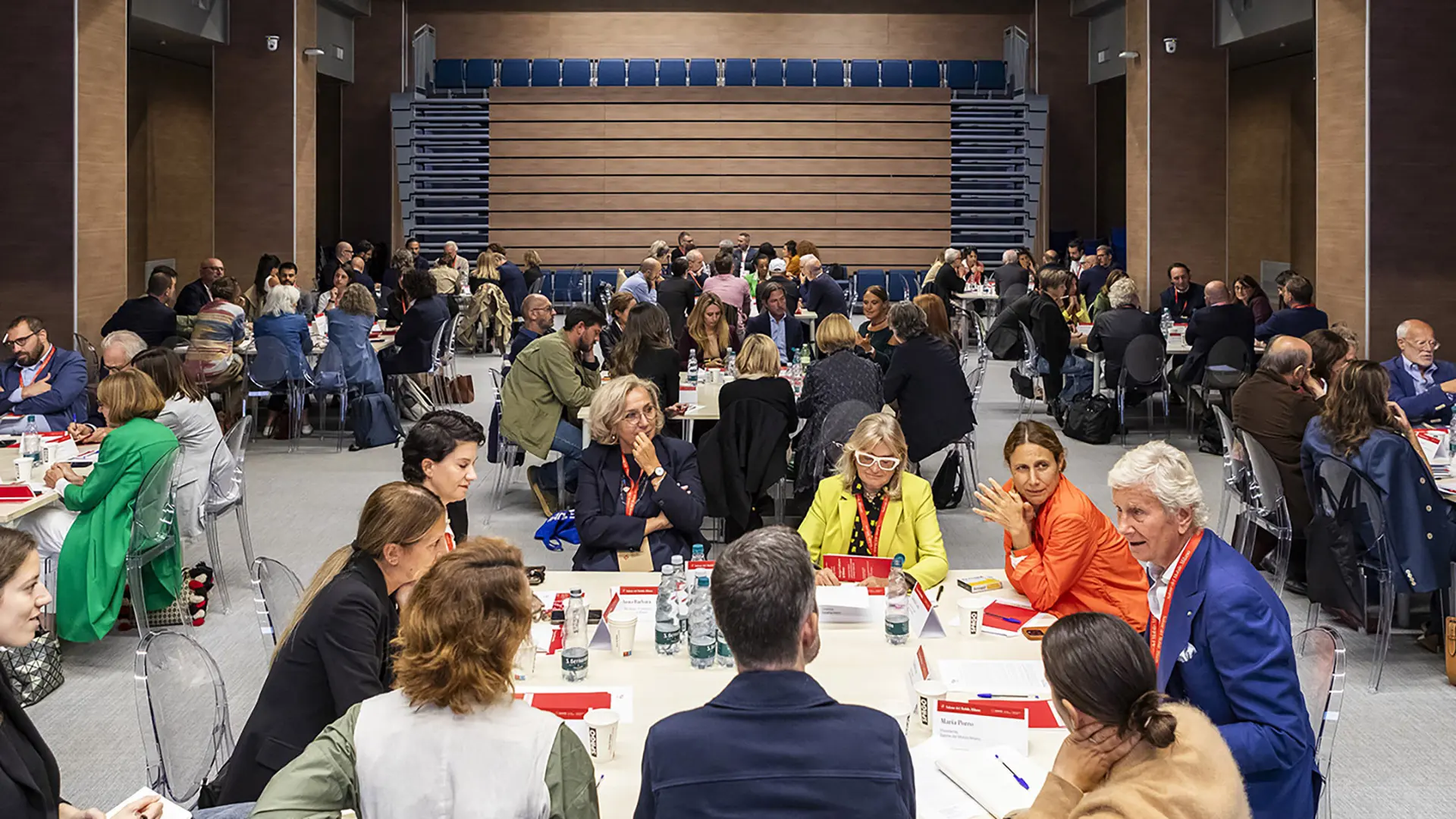Ten Thematic Tables, ten Content Leaders, with over a hundred stakeholders taking part. This was the 2025 edition of the encounter devoted to the research project measuring the impact and legacy of the Salone del Mobile and the events across the city
Assobagno presents the Bathroom Design Monitor with its focus on consumers

Elia Vismara, President of Assobagno of FederlegnoArredo, during the unveiling of the foundings of the Bathroom Design Monitor 2025
The survey conducted by NIQ-GfK Italia for Assobagno di FederlegnoArredo examined 3,000 consumers in Italy, France and Germany. The data confirm the centrality of the bathroom and highlight some (pleasant) surprises
“We live in a kaleidoscopic world. Just twist the tube and the view changes”. With this image, Elia Vismara, President of Assobagno of FederlegnoArredo, opened the day of discussions devoted to unveiling the findings of the Bathroom Design Monitor on November 19 before a large audience of operators, distributors and journalists in the sector.
The bathroom is a world of multifaceted complexity. Within a few square meters it contains appliances that differ in materials, shapes, functions, design and uniqueness. This means that the reference market necessarily addresses a multiplicity of channels.
Consumers at the centre of the research
“We have always conducted investigations in depth into production and distribution and, laterally, also into the work of architects, but until now we hadn’t put consumers under a magnifying glass”, explains Vismara who, as the President of Assobagno, pushed strongly for this research. Through 3,000 telephone interviews on a sample of consumers in Italy, France and Germany, engaged in recent bathroom renovations or intending to do so in the next 18 months, the research analysed their types of behaviour, decision drivers and preferred channels, mapping the path of purchase and opening up the discussion with leaders in distribution.
Purchasing behaviours
“The Bathroom Design Monitor was created to offer operators concrete tools for interpreting the evolution of purchasing behaviour”, Elia Vismara points out. “The survey reveals better informed and more aware consumers, who switch naturally between physical and digital media. The point of sale still provides an essential frame of reference, but the decision-making begins much earlier online. For companies and distribution, it means guaranteeing consistency, competence and service across the whole cycle”. It is surprising, for example, that 57% of Italian respondents (54% at the European level) consider the bathroom as the fulcrum of domestic well-being. “Stated by the end consumer, this is a significant figure”, Vismara observed.

Bathroom Design Monitor 2025
The round table
The data that emerged from the survey carried out by NIQ-GfK Italia for Assobagno of FederlegnoArredo was the subject of a lively round table, moderated by journalist Filippo Poletti under the motto “better accompanied than alone”. The reference is to consumers who buy in stores and points of sale (representing 90% of the total). Taking part in the discussion were Maurizio Lo Re (President of Angaisa), Ferdinando Napoli (CEO and Co-founder Archiproducts) and Tommaso Moroni (General Manager Arky powered by Leroy Merlin).
In Italy, the staff in sales points are the main influencers of choices, where technical competence and listening skills are more than decisive for building trust. “Mrs. Marie Antoinette” – or the evolution of “Mrs. Marie” as a final consumer – explained the President of Angaisa, “is very well informed and has clear ideas about what she wants to buy. The training of sales consultants is crucial and the game is played out in the physical store. Even more so if you have the product ready for delivery. But this is not all: it is important for the showroom to be always updated and well designed, just as the display has to be up to date and the consultants highly competent. And a further lever is word of mouth”. Online reviews and experts are consulted, but they have less influence on the final decision. In fact, the survey highlights the existence of well informed consumers, looking for inspiration and personalized solutions and often involving the integration of different channels (both physical and digital) in collecting information and finalising purchases. It turns out that 97% of European consumers seek information before making a purchase, and 44% do so online—a practice that cuts across all age groups.
The results of the survey in relation to the Salone Bagno 2026
“Certainly, knowledge of market dynamics is useful regardless”, observes Elia Vismara. “But some data are surprising. For instance, we discover that in Germany the architect is much less involved than in the Italian market, while the French market has a much more important DIY and large-scale distribution component. In one we look more for quality, in the other we look more for price, ad in all cases functionality is crucial. Sturdiness is one of the factors most in demand, and those who visit a store have a deep knowledge of the product acquired online, but the store’s consultancy is still important. NIQ-GfK Italia defines this an omnichannel attitude: not a preference for a single channel, but a mix of the whole. At the Salone Bagno 2026 we will certainly take this into account, as well as in the way we angle our advertising. The Italian bathroom stands for quality, from design to production and innovation. We’re still growing. It’s a great challenge”.


 Stories
Stories








